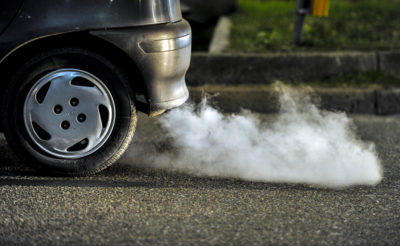By Joe Zietsman, Haneen Khreis, and Tara Ramani
If recent trends continue, more than 6 million roadway crashes will happen this year in the U.S. Even if your safe driving habits and good luck help you to avoid being in one of them, what happens on our streets and highways is, nonetheless, almost certain to affect your health — even if you don’t drive, ride, or walk.
To be at risk, all you have to do is breathe.
Along with impairment, distraction, and fatigue, we can also count breathing as a roadway risk factor because traffic-related air pollution is a persistent threat to our health, though it’s not as easily quantified or routinely monitored as other road dangers are. Crashes are violent and powerfully vivid events, instantaneous in their outcomes, requiring little effort on our part to grasp their impact. Air pollution is less dramatic, wreaking its havoc more slowly and quietly, obscuring the fact that it kills far more people annually than motor vehicle crashes.
 Respiratory disease is a leading cause of illness and death in the U.S. every year, especially in children, who are more vulnerable to the effects of air pollution. And although outdoor air quality has generally improved since the 1990s, transportation sources still constitute more than half of the air pollution that Americans encounter every day.
Respiratory disease is a leading cause of illness and death in the U.S. every year, especially in children, who are more vulnerable to the effects of air pollution. And although outdoor air quality has generally improved since the 1990s, transportation sources still constitute more than half of the air pollution that Americans encounter every day.
At the same time, both population and vehicle volumes are growing steadily, putting more people near traffic sources of air pollution. So, while roadway vehicles continue to make us very mobile, efficient, and productive, they’re also making us very sick.
- A 2010 study by the Health Effects Institute found that vehicle emissions can have adverse health effects for anyone within 300 to 500 meters of a highway or major road – areas where 30 to 45 percent of all people in North America live. Those adverse effects include, but are not limited to: premature birth and low birth weight, cardiovascular disease, lung cancer, and asthma.
- In conservative estimates, research from The World Bank in 2014 attributed 189,000 deaths worldwide in 2010 to traffic-related air pollution. Deaths over the past two decades attributable to air pollution (much of which comes from road traffic) have increased by 11 percent.
- A 2018 study in Bradford, U.K. found that up to 24 percent of all new annual childhood asthma cases may be specifically attributable to air pollution from traffic.
At the Center for Advancing Research in Transportation Emissions, Energy, and Health (CARTEEH), we’re working to better understand the ways and the degrees to which transportation emissions directly affect public health. We’ve brought together experts from two distinct disciplines – transportation and public health – who in the past haven’t routinely worked together, to find answers to some very pressing questions. Among them:
- How do emissions from trucks and cargo ship engines affect the health of people living and working near sea ports?
- How does traffic-related pollution affect the health of people living and working near U.S.-Mexico border crossings?
- To what extent do active living practices (like walking and bicycling) increase exposure to traffic-related emissions for people in underserved populations?
- What is the childhood burden of disease attributable to traffic-related air pollution across the U.S.?
It’s simply getting more difficult to avoid traffic-related air pollution. Electrified cars offer no escape; fuel for those cleaner vehicles comes from power plants, most of which dump their emissions into the same air that we breathe – albeit some distance away. A healthy economy adds to the challenge; more consumer spending leads to more shipping, involving more truck traffic, which produces more emissions. We find no panacea in technology, either, as automated and connected vehicles may result in more vehicle travel. Again, more emissions.
For many of us, it’s easy to relegate this to a list of “big-city” problems, dismissing it as virtually non-existent if we can’t literally see it, like we see the ominous haze blanketing a major urban core on ozone action days. But be assured, if you live near busy streets and highways, it’s affecting you more than you might suspect, and more than it should.
Vehicle crashes kill nearly 40,000 Americans every year. But traffic-related pollution is killing us, too. It’s just doing so more slowly and quietly than crashes typically do.
This story also appeared in the April 22, 2018, edition of the San Antonio Express-News. View the story.
Joe Zietsman is the Director of the Center for Advancing Research in Transportation Emissions, Energy, and Health (CARTEEH) at the Texas A&M Transportation Institute. Haneen Khreis is an Assistant Research Scientist at CARTEEH. Tara Ramani is an Assistant Director for Research at CARTEEH.